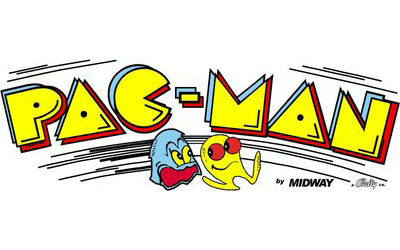
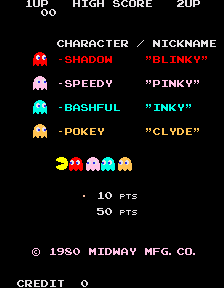
| Game: | Pac-Man |
| Developer: | |
| Publisher in Japan/Europe: | |
| Publisher in US: | |
| Designer: | Toru Iwatani - Game Designer; Hideyuki Mokajima San- Programmer; Toshio Kai - Sound & Music |
| Release Date Japan: | |
| Release Date US: | |
| Class: | Wide Release |
| Genre: | Maze |
| Game-play: | Alternating |
| Simultaneous Players: | 1 |
| Max Players: | 2 |
| Monitor: | Vertically oriented, 224 x 288, 16 palette colors |
| Joystick: | 4-way joystick |
| Layout: | Bezel, Control Panel, PCB |
| Cabinet Type(s): | Standard upright; Mini-upright (Cabiret); Cocktail; |
| Cabinet Pics: | N/A |
| Side Art: | N/A |
| Boards: | N/A |
| Arcade CPU: | 1x ZiLOG Z80 @ 3.072 MHz |
| Sound: | 1x Namco WSG (3-channel mono) @ 3.072 MHz |
| Misc: | Dip Switch Settings |
| Review Score: | |
| Player Guide: | N/A |
| Cheats: | N/A |
| Read The Review: | N/A |
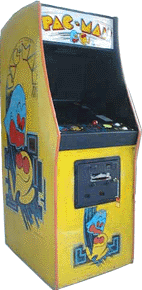 Pac-Man is an arcade game developed by Namco (now Bandai Namco) and licensed for distribution in the USA by Midway, first released in Japan in 1979. Immensely popular in the United States from its original release to the present day, Pac-Man is universally considered as one of the classics of the medium, virtually synonymous with video games, and an icon of 1980s popular culture. Upon its release, the game became a social phenomenon that sold a bevy of merchandise and also inspired an animated television series and a Top 40 pop single.
Pac-Man is an arcade game developed by Namco (now Bandai Namco) and licensed for distribution in the USA by Midway, first released in Japan in 1979. Immensely popular in the United States from its original release to the present day, Pac-Man is universally considered as one of the classics of the medium, virtually synonymous with video games, and an icon of 1980s popular culture. Upon its release, the game became a social phenomenon that sold a bevy of merchandise and also inspired an animated television series and a Top 40 pop single.
When Pac-Man was released, most arcade video games in North America were primarily space shooters such as Space Invaders and Defender or Asteroids; the most visible minority were sports games (mostly derivative of Pong). Pac-Man succeeded by creating a new genre and appealing to both males and females. Pac-Man is often credited with being a landmark in video game history, and is among the most famous arcade games of all time. The character also appears in more than 30 officially licensed games and sequels, as well as in numerous unauthorized clones and bootlegs.
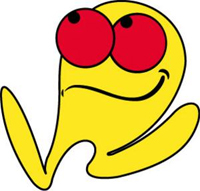 History
History
The game was developed primarily by Namco employee Toru Iwatani over 18 months. The original title was pronounced pakku-man and was inspired by the Japanese onomatopoeic phrase paku-paku taberu, where paku-paku describes (the sound of) the mouth movement when widely opened and then closed in succession. Although it is often cited that the character’s shape was inspired by a pizza missing a slice, he admitted in a 1986 interview that it was a half-truth and the character design also came from simplifying and rounding out the Japanese character for mouth, kuchi (?) as well as the basic concept of eating. Iwatani's efforts to appeal to a wider audience  beyond the typical demographics of young boys and teenagers  would eventually lead him to adding elements of a maze. The result was a game he entitled Puck Man. When first launched in Japan in 1979 by Namco, the game received a lukewarm response, as Space Invaders and other similar games were more popular at the time.
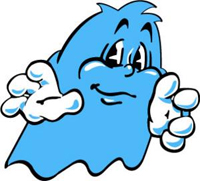 The following year, the game was picked up for manufacture in the U.S. by Bally division Midway, under the altered title Pac-Man (see below). American audiences welcomed a breakaway from conventions set by Space Invaders, which resulted in unprecedented popularity and revenue that rivaled its successful predecessor, as even Iwatani was impressed with U.S. sales. The game soon became a worldwide phenomenon within the video game industry, resulting in numerous sequels and merchandising tie-ins. Pac-Man’s success bred imitation, and an entire genre of maze-chase video games soon emerged.
The following year, the game was picked up for manufacture in the U.S. by Bally division Midway, under the altered title Pac-Man (see below). American audiences welcomed a breakaway from conventions set by Space Invaders, which resulted in unprecedented popularity and revenue that rivaled its successful predecessor, as even Iwatani was impressed with U.S. sales. The game soon became a worldwide phenomenon within the video game industry, resulting in numerous sequels and merchandising tie-ins. Pac-Man’s success bred imitation, and an entire genre of maze-chase video games soon emerged.
Competitors and distributors were taken completely by surprise by Pac-Man's success in North America in 1980. Marketing executives who saw Pac-Man at a trade show prior to release completely overlooked the game (along with the now classic Defender), while they looked to a racing car game called Rally-X as the game to outdo that year. The appeal of Pac-Man was such that the game caught on immediately with the public; it quickly became far more popular than anything seen in the game industry before. Pac-Man outstripped Asteroids as the greatest selling arcade game of the time, and would go on to sell over 350,000 units.
 Localization
Localization
For the North American market, the name was changed from PUCK MAN to Pac-Man because puck was similar in spelling and pronunciation to the common English expletive fuck, and vandals could easily change it. PUCK MAN and Pac-Man machines can be found throughout Europe.
When Midway released Pac-Man in the United States, the company also redesigned the cabinet's artwork, as the Namco-style artwork was more costly to mass produce, as well as being considered too stylish for the American market. PUCK MAN was painted overall white featuring multicolored artwork on both sides with cheerful Puck-Man characters in different poses while Pac-Man was painted yellow, with very simple and easy-to-stencil artwork on both sides and front.
Gameplay
The player controls Pac-Man through a maze, eating dots. When all dots are eaten, Pac-Man is taken to the next stage. Four ghosts (known to most gamers as Blinky, Pinky, Inky and Clyde) roam the maze, trying to catch Pac-Man. If a ghost touches Pac-Man, a life is lost. When all lives have been lost, the game ends.
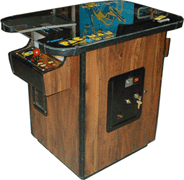 Near the corners of the maze are four larger, flashing dots known as "energizers" or "power pellets", which provide Pac-Man with the temporary ability to eat the ghosts. The ghosts turn deep blue, reverse direction, and usually move more slowly when Pac-Man eats an energizer. When a ghost is eaten, its eyes return to the "ghost pen" where it is regenerated in its normal color. Blue ghosts flash white before they become dangerous again and the amount of time the ghosts remain vulnerable varies from one board to the next, but the time period generally becomes shorter as the game progresses. In later stages, the ghosts do not change colors at all, but still reverse direction when an energizer is eaten.
Near the corners of the maze are four larger, flashing dots known as "energizers" or "power pellets", which provide Pac-Man with the temporary ability to eat the ghosts. The ghosts turn deep blue, reverse direction, and usually move more slowly when Pac-Man eats an energizer. When a ghost is eaten, its eyes return to the "ghost pen" where it is regenerated in its normal color. Blue ghosts flash white before they become dangerous again and the amount of time the ghosts remain vulnerable varies from one board to the next, but the time period generally becomes shorter as the game progresses. In later stages, the ghosts do not change colors at all, but still reverse direction when an energizer is eaten.
In addition to dots and energizers, bonus items, usually referred to as fruits (though not all items are fruits) appear near the center of the maze twice per level. These items score extra bonus points when eaten. The items change and bonus values increase throughout the game.
Pac-Man is awarded a single bonus life at 10,000 points by default. DIP switches inside the machine can change the required points or disable the bonus life altogether.
The unique game design inspired game publishers to be innovative rather than conservative, and encouraged them to speculate on game designs that broke from existing genres. Pac-Man introduced an element of humor into video games that designers sought to imitate, and appealed to a wider demographic than the teenage boys who flocked to the action-oriented games.
The Killer List of Video Games lists Pac-Man as the #1 video game of all time on its "Top 10 Most Popular Video games" list. Pac-Man, and other video games of the same general type, are often cited as an identifying cultural experience of Generation X, particularly its older members, sometimes called Baby Busters.
Scoring:
Maze Points:
- Dot: 10 points
- Power Pill: 50 points
 Ghosts eaten per power pill: 1st - 200, 2nd - 400, 3rd - 800, 4th - 1,600 points
Ghosts eaten per power pill: 1st - 200, 2nd - 400, 3rd - 800, 4th - 1,600 points
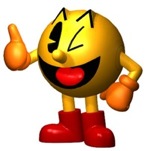 Bonus Items:
Bonus Items:
 Cherry: 100
Cherry: 100 Strawberry: 300
Strawberry: 300 Orange: 500
Orange: 500 Apple: 700
Apple: 700 Melon: 1,000
Melon: 1,000 Galaxian Boss: 2,000
Galaxian Boss: 2,000 Bell: 3,000
Bell: 3,000 Key: 5,000 points
Key: 5,000 points
Intermissions
During the opening boards of the game, the linearity of the game's progression is interrupted by "intermissions" - humorous animated scenes featuring Pac-Man and the ghosts. There are three different intermissions:
1. Blinky chases Pac-Man off the screen. Blinky reappears as a vulnerable blue monster coming the opposite direction, being chased by a giant Pac-Man. This intermission plays after Board 2.
2. Blinky chases Pac-Man across the screen, but his pelt is caught on a tack in the floor, and part of it is ripped off revealing his pinkness. This intermission plays after Board 5.
3. Blinky, with the corner of his pelt sewn back on, chases Pac-Man across the screen. Blinky reappears coming back the opposite direction, pinked, dragging his pelt behind him. This intermission plays after Boards 9, 13 and 17.
Perfect Play
A perfect Pac-Man game is defined as one where the player completes all 256 levels with a maximum point score and without losing a life. The first such game was verified by the Twin Galaxies Intergalactic Scoreboard on July 3, 1999. Billy Mitchell, of Hollywood, FL, achieved the feat in six hours. To attain the maximum possible score of 3,333,360 points, it was necessary for Mitchell to eat every fruit, every Power Pellet, every blue ghost and every dot for 256 boards without losing a single life.
Split-Screen Level
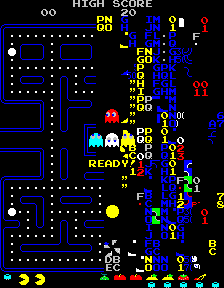 This game technically has no end; the player will be given new boards to clear as long as Pac-Man does not lose all of his lives. However, due to a glitch in the game, the right side of the 256th board is a garbled mess of text and symbols rendering the level unplayable. This occurs because of a bug in the subroutine that draws the fruit at the bottom of the screen that indicate the current level. Normally, at most 7 fruits are displayed, regardless of the current screen, but since the level number is stored in a single byte, level 255 ("FF" in hexadecimal) rolls over to 0 in the subroutine, and 256 fruit are drawn, corrupting the bottom of the screen and the entire right half of the maze. Enthusiasts refer to this as the "Final Level," the "Split-Screen Level," or simply as the ending. Although there are claims that someone with enough knowledge of the maze pattern can play through it, it is generally considered impossible to be cleared via legitimate means.
This game technically has no end; the player will be given new boards to clear as long as Pac-Man does not lose all of his lives. However, due to a glitch in the game, the right side of the 256th board is a garbled mess of text and symbols rendering the level unplayable. This occurs because of a bug in the subroutine that draws the fruit at the bottom of the screen that indicate the current level. Normally, at most 7 fruits are displayed, regardless of the current screen, but since the level number is stored in a single byte, level 255 ("FF" in hexadecimal) rolls over to 0 in the subroutine, and 256 fruit are drawn, corrupting the bottom of the screen and the entire right half of the maze. Enthusiasts refer to this as the "Final Level," the "Split-Screen Level," or simply as the ending. Although there are claims that someone with enough knowledge of the maze pattern can play through it, it is generally considered impossible to be cleared via legitimate means.
However, in December 1982, an eight-year-old boy named Jeffrey R. Yee received a letter from U.S. President Ronald Reagan congratulating him on a worldwide record of 6,131,940 points, a score only possible if the player has passed the Split-Screen Level. Whether or not this event happened as described has remained in heated debate amongst video game circles since its supposed occurrence. In September, 1983, Walter Day, Chief Scorekeeper at the Twin Galaxies Intergalactic Scoreboard, took the U.S. National Video Game Team on a tour of the East Coast to visit video game players who claimed they could get through the "Split-Screen." No video game player could demonstrate this ability. Later, in 1999, Billy Mitchell offered $100,000 to anyone who could provably pass through the Split-Screen Level before January 1, 2000; there is no evidence that anyone could.
Through tinkering, the details of the Split-Screen Level can be revealed. As playable through arcade game emulator MAME some ROMs of the game are equipped with a "rack test" within the DIP switches that will automatically clear a level of all dots as soon as it begins. This method not only makes reaching the long-mythical 256th board easier (thus making detailed analysis possible) but also allows a demonstration of what happens after the board has been cleared:
Because the right side of the map does not exist, Pac-Man and the ghosts can move freely throughout the right side of the screen, barring some of the garbled symbols which are fractured pieces of the maze. Other symbols also entail power pills, which must be eaten for the player to continue (unlike the unglitched boards, if Pac-Man loses a life, the pills on the right side of the screen will reset after being eaten). Because the maze fracture blockades are "placed" in many locations, it is difficult - if not impossible - to locate them all.
If the board is cleared, the game restarts from the first board without error, once again repeating through 256. However, while the power-ups and intermissions repeat from the opening of the game, the monsters will retain their speed and invulnerability to power pellets from the later boards.
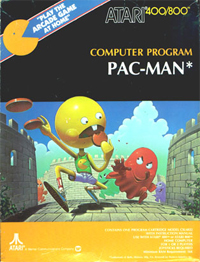 Ports
Ports
Pac-Man is one of the few games to have been consistently re-released for over two decades. In the 1980s, it was released for the Atari 2600, Atari 5200, Atari 8-Bit Computers (400/800/etc.), Intellivision and Commodore 64, and the Nintendo Entertainment System (1987 and 1990). In the handheld world, it was released on the Game Boy (1991), Sega Game Gear (1991), Neo-Geo Pocket Color (1999), Pac-Man: Special Color Edition for the Game Boy Color (1999), Apple iPods (fifth generation), Pac-Man Collection for the Game Boy Advance (2001), and it is unlockable in Pac 'n Roll for the Nintendo DS. However, it has been most widely distributed in Namco's long-running Namco Museum series, starting on the PlayStation in 1996 and continuing to this day on every major console (as well as the PSP and Game Boy Advance) with the 50th Anniversary Collection (2005). An Xbox 360 port was released via Xbox Live Arcade on August 9, 2006. Pac-Man is also available in its original form as part of the GameTap service. On September 12, 2006 a port was released for play on the popular iPod music player along with other arcade/puzzle games. Pac-Man was never ported to the Atari 7800 home video game system. However, there have been efforts to hack the pre-existing Ms. Pac-Man cartridge to create the original Pac-Man (as well as other Pac-Variants) for it.
Namco has repeatedly re-released this game in arcades. In 2001, Namco released a 20-Year Reunion game that combined Ms. Pac-Man and Galaga in one cabinet. To play the original Pac-Man on this machine, move the joystick in this order on the "Press Start Button" that appears after inserting the coin(s): up, up, up, down, down, down, left, right, left, right, left. If done correctly, one should hear a sound, and Ms. Pac-Man will change color. Press the Ms. Pac-Man start button, and one will be able to play Pac-Man. It should be noted that Ms. Pac-Man machines are far easier to locate in today's arcades than a dedicated Pac-Man. In 2005, Namco released a board openly featuring all three of the games on the 20-Year Reunion board in honor of Pac-Man's 25th Anniversary.
The NES version was successful enough to become one of the Classic NES Series GBA games.
Namco's wireless division released a line of PAC-MAN games for the cell phone in 2002, starting with the original arcade version and following up with Pac-Man game extensions like Pac-Man Bowling and Pac-Man Pinball. This division (Namco Networks America Inc.) also launched a networked game, Ms. Pac-Man For Prizes, in 2004. Pac-Man mobile games are available on both BREW and Java platforms across major cellular carriers, as well as on Palm PDAs and Windows PC phones.
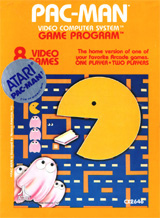 Atari 2600 Port
Atari 2600 Port
The Atari 2600 version of Pac-Man was developed and published by Atari in 1982. It was the first port of the arcade game, Atari being the licensee for the video game console rights. Although Atari sold seven million units, out of a 10-million 2600-user base, this port may have been rushed to market and its quality was widely criticized. Atari, having manufactured 12 million cartridges under the expectation that the game would increase the number of sales of the console, was left with a large unsold inventory that had to be written-off, incurring in large financial losses for the company. This was one of the catalysts that led to the video game crash of 1983.
Spin-offs
Sequels
Pac-Man spawned numerous sequels. Of these, the most significant title was Ms. Pac-Man. Originally created as an unauthorized hack of the original game called Crazy Otto by a small group known as General Computer Corporation, it was eventually sold to Bally Midway without Namco's permission. Crazy Otto was actually seen in a photograph in Time magazine, mislabeled as the original Pac-Man. The game featured several improvements and changes from the original Pac-Man, including faster game-play, more mazes, new intermissions, and moving bonus items. Some consider Ms. Pac-Man to be a superior game to the original, and even the best in the entire series. Namco sued Midway for exceeding their license. Eventually Bally Midway struck a deal with Namco to make Ms. Pac-Man an officially licensed sequel, although Midway continued to release several unauthorized spin-off games later on, such as Pac-Man Plus , Baby Pac-Man and Professor Pac-Man, resulting in Namco cancelling their contract with Midway and ceasing to do business with them. These other titles were generally considered inferior and unimportant, serving to over-saturate the market for Pac-Man games.
Microsoft worked with (Pac-Man creator) Toru Iwatani and Namco Bandai to release a re-envisioning of the game, 26 years after the original: Pac-Man Championship Edition, released on Xbox Live Arcade on June 6, 2007.
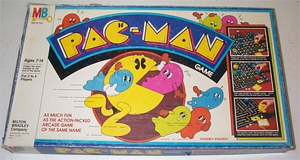 Clones and bootlegs
Clones and bootlegs
Many unauthorized "pirate" versions of the game were also created in order to profit from Pac-Man's fame and playability.
Non-video games
In 1982, Milton Bradley released a board game based on Pac-Man and another based on Ms. Pac-Man. Several other pocket games and a card game were also produced.
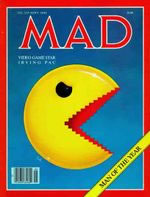
A group of students from the Computer Science department of Simon Fraser University Pac Man Of The Year - Mad Mag had developed a "life-sized" Pac-Man system, using laptops and cell phone tracking to track the location of the dots, ghost, and the Pac-Man.It has become a regular activity of Computer Science Frosh Week, and is usually played in Downtown Vancouver.
Pac-Man in popular culture
A great deal of Pac-Man merchandise was marketed in the 1980s, from t-shirts to toys to hand-held video game imitations to pasta. There was also the aforementioned Saturday morning TV cartoon called Pac-Man.
